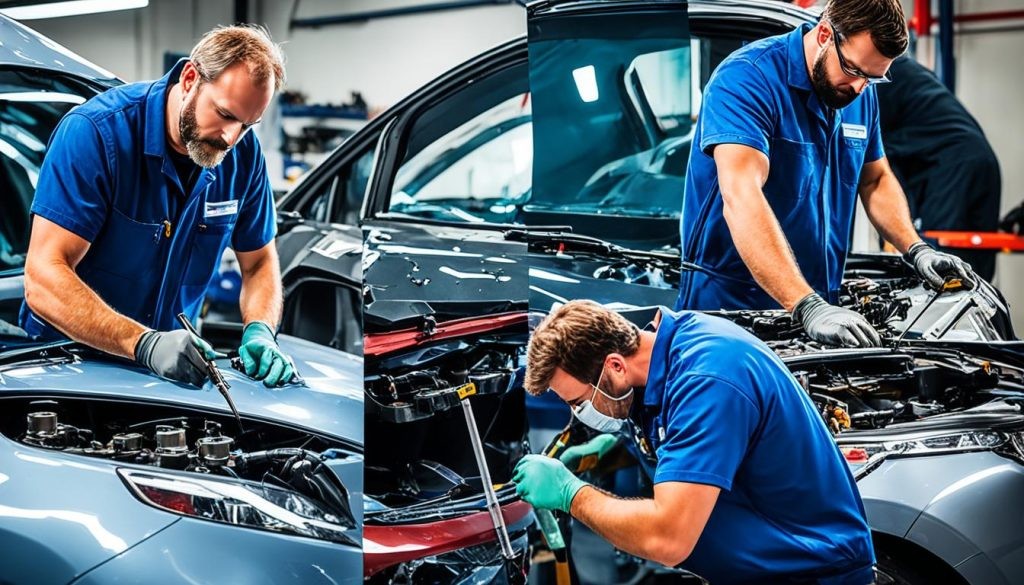Dealing with car damage, even minor auto body issues, can disrupt your life. You’re likely wondering, “How long does it take for minor auto body repair?” Knowing the answer helps you plan your schedule and manage expectations while your vehicle is being fixed. This guide will break down the typical timelines for minor auto body repairs, the stages involved, and the factors that can influence how quickly you get back on the road.
Understanding Minor Auto Body Repair Timelines
Minor auto body repairs are generally considered cosmetic or surface-level damage that doesn’t affect the structural integrity of your vehicle. These types of repairs are common after fender benders, parking lot incidents, or even environmental factors like hail. But even “minor” can feel like a long time when you’re without your car.
Average Repair Time for Minor Damage
For truly minor auto body work, you can typically expect repairs to take anywhere from 1 to 3 days. This timeframe applies to damage such as:
- Small dents: Door dings, minor fender dents, or hail damage.
- Scratches: Surface scratches that haven’t gone through the clear coat and paint layers.
- Minor bumper damage: Scuffs, scrapes, or small cracks in the bumper cover.
- Paint chips: Small areas where the paint has chipped off.
These types of repairs often utilize techniques like paintless dent repair (PDR) or spot painting, which are quicker and less intensive than major body work.
Factors That Can Affect Minor Repair Time
While 1 to 3 days is the average, several factors can influence the actual time it takes for your minor auto body repair:
- Severity of the “minor” damage: Even within “minor” damage, there’s a range. A tiny scratch will be faster to fix than multiple small dents across several panels.
- Parts availability (though less common for minor repairs): In most minor repairs, new parts aren’t needed. However, if a small trim piece or specific paint product is required and not readily available, it can add a slight delay.
- Paint matching: Ensuring a perfect paint match, especially on older vehicles or for tri-coat paints, can take extra time and precision.
- Body shop workload: Just like any service business, auto body shops have busy and slow periods. If the shop is experiencing a high volume of work, even minor repairs might take slightly longer due to scheduling.
- Insurance approval (if applicable): If you’re going through insurance for even a minor claim, the approval process can add a day or two to the overall timeline.
Stages of Minor Auto Body Repair
Even for minor repairs, a process is followed to ensure quality and a seamless finish. Understanding these stages can give you a better sense of what’s involved and why repairs take the time they do.
- Assessment and Estimate: The first step is for the body shop to assess the damage. For minor repairs, this is usually quick. They’ll examine the dents, scratches, or bumper damage and provide you with an estimate. This might take a few hours.
- Insurance Approval (if necessary): If you’re filing an insurance claim, the estimate needs to be sent to your insurance company for approval. For minor claims, this is often a faster process than for major damage, potentially taking just a day or two.
- Repair Work: This is where the actual body work happens. For minor repairs, this could involve:
- Paintless Dent Repair (PDR): Using specialized tools to massage dents out from behind the panel without damaging the paint.
- Minor Body Filler Application: For slightly deeper dents, a thin layer of body filler might be used to create a smooth surface.
- Sanding and Priming: Preparing the area for paint.
- Painting and Blending: Carefully matching the paint color and blending it seamlessly with the surrounding areas.
- Clear Coat Application and Polishing: Protecting the paint and achieving a glossy finish.
- Quality Check and Detailing: Once the repairs are complete, the shop will perform a quality check to ensure the work meets their standards and that the paint match is perfect. They will also clean and detail the repaired area. This final stage is typically completed within a few hours.
Streamlining Your Minor Auto Body Repair
While some factors are outside your control, there are things you can do to potentially help expedite minor auto body repairs:
- Promptly get an estimate: Don’t delay in getting your car to a reputable body shop for an assessment and estimate.
- Communicate clearly with the shop: Provide all necessary information upfront and respond quickly to any questions from the repair shop.
- If going through insurance, be responsive to your insurer: Respond to requests from your insurance company promptly to avoid delays in claim approval.
- Choose a reputable and efficient body shop: An experienced shop with good reviews is more likely to complete repairs efficiently without sacrificing quality.
Conclusion: Minor Auto Body Repair Doesn’t Have to Take Long
Understanding the timeline for minor auto body repair can ease your stress and help you plan accordingly. While the average is 1 to 3 days, being aware of the factors that can influence this timeframe and the stages involved in the repair process empowers you to navigate the situation with confidence. By choosing a good repair shop and communicating effectively, you can get your car back to its pre-damage condition quickly and efficiently.
FAQ About Minor Auto Body Repair Time
Q: What’s the fastest type of minor auto body repair?
A: Paintless dent repair (PDR) is often the fastest, especially for small dents where the paint is undamaged. This can sometimes be done in a few hours or even while you wait.
Q: Could minor scratch repair take longer than 3 days?
A: In most cases, minor scratch repair should fall within the 1-3 day timeframe. However, if there are extensive scratches over multiple panels, or if paint matching is particularly complex, it could potentially take slightly longer.
Q: Will scheduling an appointment affect the repair time?
A: Yes, scheduling is always recommended. Calling ahead and booking an appointment ensures the shop can allocate time for your repair and reduces potential delays.
Q: Can I get a more precise time estimate for my specific minor damage?
A: Absolutely. The best way to get a precise estimate is to take your vehicle to a reputable auto body shop for an in-person assessment. They can evaluate the specific damage and give you a more accurate timeline based on their workload and the repair process required.
Q: Does the type of car I drive affect minor repair time?
A: Generally, for minor repairs, the type of car has less of an impact than for major repairs. Parts availability is less of a factor for minor cosmetic fixes. However, very high-end or rare vehicles might require specialized paint or techniques, which could potentially add a little time.


